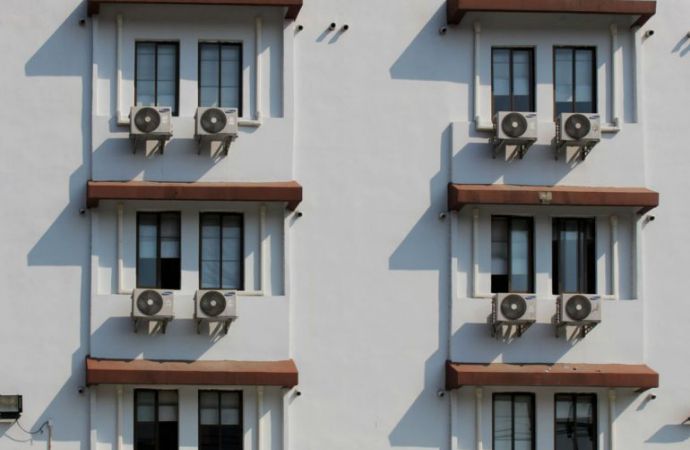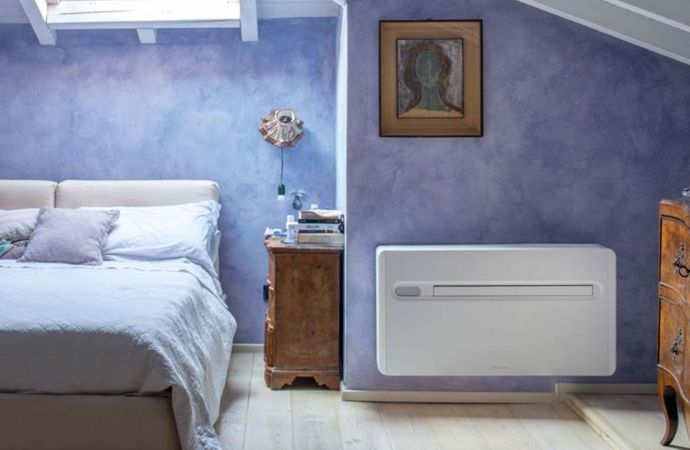Finalists include major companies and start-ups, two using R290, one likely to use R290, and two employing water in their design of climate-friendly residential AC systems.

A global coalition led by the Government of India and Rocky Mountain Institute (RMI) announced in New Delhi, India, today, the eight finalists of the Global Cooling Prize, an international innovation competition to develop super-efficient, climate-friendly and affordable residential cooling solutions for homes.
The finalists, including leading air-conditioning manufacturers as well a start-ups, showcased technologies that “reduce or eliminate refrigerants linked to climate change, advances that will be vital as the number of room air conditioners nearly quadruples by 2050,” said the announcement.
Two of the finalists (Godrej-Boyce and S&S Design Startup Solution Pvt. Ltd.) are incorporating propane (R290) in their systems, while another, Transeara, is using R32 but is "likely to transition to R290 for the prototype build," said Iain Campbell, senior fellow at the Rocky Mountain Institute. Two others (Kraton Corporation and M2 Thermal Solutions) are employing water in their technologies. Barocal Ltd's system utilizes an organic solid-state material (neopentylglycol), noted Campbell.
The other two finalists, Gree and Daikin, have selected HFC R152a and HFO R1234ze, respectively, for their systems.
The finalists have been awarded US$200,000 each to develop and ship their prototypes to India for testing in the summer of 2020. The winner of the Global Cooling Prize will be announced in November of 2020 and awarded more than US$1 million.
The following includes brief descriptions of the finalists and their systems, taken from the announcement. More details can be found later in this article.
- S&S Design Startup Solution Pvt. Ltd., based in India, has developed a two-stage cooling system integrating a water loop and a traditional vapor compression system with natural, low GWP refrigerant (R290).
- Godrej and Boyce Mfg. Co. Ltd., based in India, with partner A.T.E. Enterprises Private Limited, has designed an advanced (R290-based) vapor compression technology integrated with indirect evaporative cooling and solar PV.
- Daikin Air Conditioning India Private Limited, with partners Daikin Industries Ltd and Nikken Sekkei Ltd., has devised a vapor compression technology with novel componentry and ultra-low GWP refrigerant (R1234ze).
- Gree Electric Appliances Inc. of Zhuhai, China, with partner Tsinghua University, has developed an advanced (R152-based) vapor compression technology integrated with evaporative cooling and solar PV.
- U.S.-based Kraton Corporation, with partners Porus Laboratories, IIT Bombay and Infosys, has designed evaporative cooling (via water) with membrane dehumidification using electro-osmosis principle.
- U.S.-based M2 Thermal Solutions has devised evaporative cooling (via water) with membrane dehumidification using capillary condensation principle.
- U.S.-based Transaera Inc. has developed vapor compression technology (using R32, and likely R290 later) with desiccant dehumidification.
- U.K-based Barocal Ltd, a new spin-out from a University of Cambridge lab, for solid state Barocaloric cooling technology (using neopentylglycol).
The Global Cooling Prize was launched in November 2018 “with the aim of spurring the development of a radically more efficient, climate-friendly residential cooling solution,” with potential for five-times less climate impact, said the announcement. Its organizers include the Department of Science and Technology, Government of India; Rocky Mountain Institute (RMI), a U.S-based global research institute; and Mission Innovation, a global initiative of 24 countries and the European Union to accelerate global clean energy innovation. The initiative is also supported by Conservation X Labs, Alliance for an Energy Efficient Economy (AEEE), and CEPT University, and a coalition of over 20 leading non-profit organizations such as Virgin Unite, WWF, SE4ALL, UN Environment, and the World Economic Forum.
Since the Prize was launched, over 2,100 participant registrations from around the globe were submitted by innovators, start-ups, research institutes, universities, and key industry manufacturers in over 95 countries. Of the registered entities, 445 teams submitted preliminary ideas and 139 teams from 31 countries followed through with a full detailed technical application for the prize.
“It gives me immense satisfaction to say that we have received some absolutely revolutionary cooling ideas,’’ said Sir Richard Branson, Founder and CEO of the Virgin Group and Global Ambassador for the Prize, in the announcement. “What makes this competition especially exciting, is the market transformation opportunity. It could be one of the biggest technology-based steps we can take to arrest climate change. Congratulations to the finalists of the Global Cooling Prize. I look forward to following all of you on your journey to winning the prize and scaling your solutions globally.”
The Minister of Science and Technology, Government of India, Dr. Harsh Vardhan, who awarded the finalists, said: “Innovation is the foundation for development and growth. This important initiative aligns with the objectives of the India Cooling Action Plan that the Government of India officially released this year to bolster our R&D efforts in global climate leadership and strengthens our commitment to accelerate clean energy innovation as part of Mission Innovation’s international platform.”
What makes this competition especially exciting, is the market transformation opportunity. It could be one of the biggest technology-based steps we can take to arrest climate change." - Richard Branson, Virgin Group
Rocky Mountain Institute Chief Executive Officer Jules Kortenhorst highlighted the critical climate threat the world faces from the booming demand for comfort cooling: “The Residential / Room AC industry represents a 60-billion-dollar market today and is set to grow to nearly four times that size by 2050. The Prize initiates an era of transformation and global innovation for the cooling industry. A breakthrough technology has the potential to prevent up to 75 gigatons (GT) of CO2-equivalent emissions by 2050, whist providing affordable access to cooling in parts of the world where it is becoming a critical need.”
Population growth, urbanization, and rising income levels, compounded by a warming planet, are driving unprecedented growth in demand for comfort cooling globally; from 1.2 billion room air conditioners (RACs) in the world today, to a projected 4.5 billion by 2050, said the announcement. For the next three decades, every second 10 room air conditioners will be sold in markets around the globe, it noted.
Under business as usual scenario, a recent report by the International Labor Organization (ILO), suggests that productivity losses to the global economy from heat stress could reach $2.4 trillion a year—equivalent to 80 million full-time jobs. Lost productivity from extreme heat in India alone could exceed $450 billion by 2030. While a mere 7% of households in India own air conditioners today, demand for comfort cooling is expected to drive the total stock to over 1 billion by 2050 — a 40-fold growth from 2016.
More details on the finalists’ systems
The following details about the finalists' AC systems are from globalcoolingprize.org:
S&S Design Startup Solution Private Limited
This cooling solution combines a two-stage cooling system with direct evaporative cooling of the condenser to achieve a significantly higher efficiency as compared to the typical AC units sold today. The two-stage cooling system integrates a water loop and a traditional vapor compression system to optimize the performance. The water loop pre-cools the room air which is subsequently cooled and dehumidified to the desired conditions at the evaporator of the vapor compression system. At the condenser section, a part of this conditioned air is further cooled using direct evaporative cooling, thus significantly improving the condensing efficiency.
The performance is further optimized by using a variable speed compressor and with the application of a natural, low-GWP refrigerant, the proposed solution has the potential to achieve dramatically lower climate impact. The use of DC electrical componentry in the design allows for easy integration with renewable power sources, and together with the solution’s low-cost potential, provides an opportunity for increased access to cooling.
Daikin AirConditioning India Private Limited, Daikin Industries Ltd., and Nikken Sekkei Ltd
The cooling system adopts the following two innovative methods to achieve higher efficiency and lower climate impact cooling solution. First, a multi split method is used to connect three indoor units with one outdoor unit. This method helps optimize refrigerant flow rate for each of three indoor units depending on ever-changing cooling load and use refrigerant control technology to closely modulate the capacity. Second, evaporative cooling method is used to improve the system efficiency by using heat of vaporization to lower the temperature of the air that outdoor unit takes in. The system will use control technology which measures the outdoor temperature with sensors and applies the control system to automatically spray water under the conditions with high ambient temperature where cooling load sees particularly high.
Godrej and Boyce Mfg. Co. Ltd. and A.T.E. Enterprises Private Limited
This cooling technology integrates a Godrej’s own well-established high-efficiency vapor compression system with a natural and low global warming potential refrigerant and advanced evaporative cooling technology to provide cooling. This technology is expected to have a significantly lower climate impact as compared to the typical RAC units sold today.
The advanced evaporative cooling technology reduces the air temperature without adding to its humidity level. This cool air is then either supplied directly to the indoor space or passes through the vapor compression system which optimizes compressor performance depending on the set indoor temperature and humidity requirements of the space. The grid electricity consumption of the cooling system is further reduced by improving the heat exchanger efficiency and by using a small integrated solar PV panel to offset part of the total power demand of the solution. The integration of these advanced technologies is achieved through smart controls that optimize the performance of this integrated solution.
Gree Electric Appliances Inc. of Zhuhai and Tsinghua University
The innovative hybrid solution is designed to have an automatic, climate-smart operation in three unique modes – vapor compression refrigeration, direct evaporative cooling, and ventilation – which will switch between each other or operate the three modes in parallel to each other depending on the outside weather conditions to provide optimized indoor cooling. The vapor compression refrigeration mode of the cooling solution adopts an innovative temperature-humidity-independent-control cycle. It uses an ingenious compressor technology with a low global warming potential (GWP) refrigerant in conjunction with improved design of evaporator and condenser systems to more effectively cool and dehumidify the air, thus using dramatically less energy than today’s typical products.
The solution has a small solar PV panel integrated into the outdoor unit to further lower the overall grid-electricity consumption of the solution. This hybrid cooling solution not only demonstrates the application of a low GWP refrigerant, it also highlights the extent by which the efficiency of today’s predominant technology, vapor compression technology, can be expanded through smart, hybrid design.
Kraton Corporation, IIT Bombay, Porus Laboratories, and Infosys
NexarCool™ technology integrates an electro-osmotic membrane dehumidifier with a water-based direct evaporative cooling system to achieve air conditioning without using any refrigerant.
By applying a small voltage across the membrane dehumidifier system, water vapor from the indoor air is ejected to the outside air, thus making the indoor air dry in the process. The dry indoor air is then cooled via a direct evaporative cooling process, where the moving air loses its heat to evaporate the water, and in the process, gets cooled. This integrated approach to cooling is expected to have significantly lower energy consumption than conventional air conditioners sold today. Additionally, as no refrigerant is used, the technology has the potential to dramatically lower climate impact.
M2 Thermal Solutions
This cooling solution integrates an evaporative cooling technology with a membrane system in a packaged design that is able to independently cool and dehumidify room air, which enables dramatically less energy to be consumed. In this system, an evaporative cooler first operates to cool the room air while increasing its humidity. The cool and humid air is then passed through a membrane system to remove the excess water vapor from the cool air, thus decreasing its humidity.
The solution also has the capability to bypass either of these processes, and just use a ventilation mode depending on the outdoor weather conditions. Furthermore, the vast majority of the water supplied to the evaporative cooler is generated by the membrane system – thus minimizing the water footprint of the solution. With no compressor or refrigerant, and an innovative approach to independent cooling and dehumidification, this solution has the potential to achieve significantly lower climate impact than typical AC units sold today.
Transaera Inc.
The cooling solution is designed to operate a high efficiency room air conditioner in parallel with a moisture storage battery (MSB) to provide cooling and dehumidification while using dramatically less energy than typical room air conditioners sold today.
By separating the temperature and humidity control processes, this air conditioner has the potential to reduce the energy consumption significantly while providing the desired comfort level. Humid air is difficult to cool because of the large amount of water vapor in the air. Transaera’s Moisture Storage Battery (MSB), comprising of a novel desiccant material, has the capacity to adsorb a large amount of moisture allowing room air to dehumidify. Dry air is easier to cool with the high-efficiency AC unit, thus reducing the overall electricity consumption.
Additionally, while typical desiccant materials require a high-temperature source for regeneration, the MSB material can regenerate using waste heat from the vapor compression system as and when it gets saturated, thus reducing the energy consumption of the overall solution. The system also has a provision for direct evaporative cooling of air at the condenser inlet to improve condensing efficiency, a small integrated solar PV panel and battery to reduce grid-consumption and collects rain-water for use to improve the overall environmental impact of the solution.
Barocal Ltd.
This non-vapor compression technology, known as Barocaloric cooling technology, could potentially transform the existing air conditioning technology and make it more climate friendly.
Instead of using high global warming potential (GWP) refrigerant gases such as HFCs or HCFCs common to vapor compression technology, this solid-state Barocaloric cooling technology takes advantage of the properties of solid organic “plastic crystal” materials to provide cooling. By applying pressure to these organic solid crystals, it is possible to change their molecular orientation which results in a solid state phase transition, thus causing a change in their entropy (degree of disorder) which leads to a temperature change of the system.
The process of continuously “applying and releasing pressure” on the Barocaloric material results in solid-to-solid phase changes in the crystals which results in large thermal changes due to molecular reconfiguration. This produces a cooling effect which can be delivered either to the room air or to produce chilled water for cooling. These plastic crystals are flexible materials that are widely available and are low-cost and non-toxic. Research shows that the thermodynamic behavior of these plastic crystal materials is very similar to commonly used refrigerants, which has the potential to create a viable and alternative cooling approach to the century-old vapor compression technology.
Related stories



